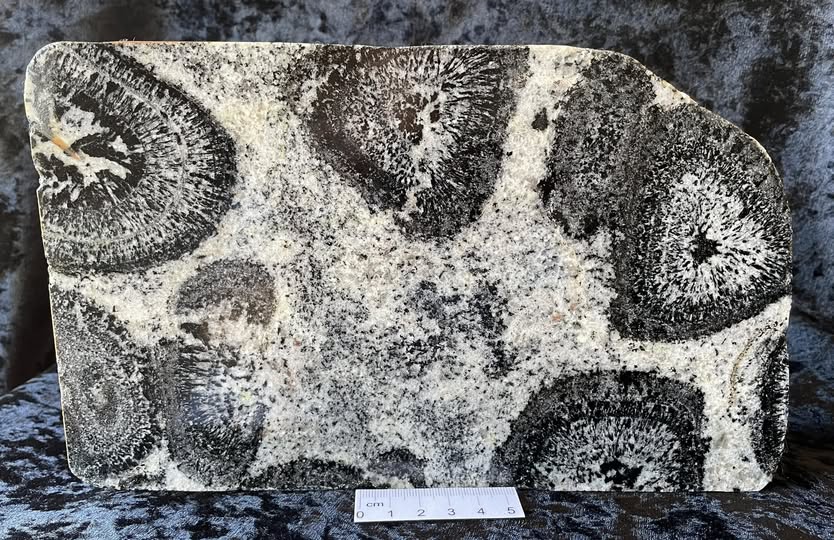
Fascinating Orbicular Granite from Mt Magnet, Western Australia
Share
Orbicular granite is an extraordinary and rare type of igneous rock, notable for its stunning orbicular structures. One of the most renowned occurrences of this fascinating rock is found at Boogardie Station, approximately 35 kilometers west of Mount Magnet in Western Australia. This remarkable geological wonder captivates geologists with its distinctive orbicules—spherical formations composed of concentric mineral layers. Their unique structure and captivating appearance make this granite a subject of ongoing fascination and scientific study.
Geological Features
The orbicular granite at Boogardie Station is hosted by a pink, medium-grained granitic rock from the late Archean era. This host rock primarily comprises myrmekitic biotite granodiorite, which transitions to tonalite in certain areas. The orbicules within this granite are primarily composed of concentric shells of hornblende and feldspar crystals, densely packed within the host granite. These orbicules are typically ellipsoidal but can also be near-spherical, irregular, or fragmented in shape, adding to their unique appeal.
Formation and Composition
The formation of orbicular granite remains a topic of active research, but it is generally believed that these unique structures formed as saucer-shaped, sill-like bodies within the host granodiorite-tonalite. The orbicules are enveloped by a mid- to dark grey outer shell, composed of fine- to medium-grained hornblende, biotite, and plagioclase feldspar. Inside this protective shell, the orbicules exhibit a hornblende diorite composition, primarily consisting of plagioclase feldspar and hornblende. The processes that led to the formation of these orbicules are still being studied, but they likely involve complex interactions between magmatic and hydrothermal activities.
Significance and Uses
Orbicular granite is not only a geological marvel but also holds practical applications. Its unique and eye-catching texture makes it a popular choice for ornamental stone in various architectural and decorative projects. The Boogardie quarry actively produces orbicular granite for such purposes, making it a valuable resource.
Orbicular granite from the Boogardie quarry is highly prized both within Australia and internationally. Its striking appearance and rarity make it a sought-after material for designers and architects around the world.
Export and Use
-
Australia: Within Australia, orbicular granite is used in various high-end architectural and decorative projects. It adds a touch of elegance and natural beauty to homes, public buildings, and outdoor spaces.
-
International Markets: The granite is also exported to other countries, where it is used in exclusive design projects. International designers and architects seek this rare stone for its unique aesthetic qualities. Countries in Europe, North America, and Asia are among the recipients of this prized granite.
Applications
-
Ornamental Stone: Sculptures, countertops, and decorative features.
-
Architectural Projects: Building facades, flooring, and structural elements.
-
Interior Design: Wall claddings, fireplace surrounds, and tabletops.
The demand for this extraordinary stone extends far beyond the borders of Australia, contributing to its global reputation as a valuable and sought-after resource. The Boogardie quarry continues to share this geological wonder with the world, allowing people everywhere to appreciate and utilize its unique beauty.
Global Occurrences
Although orbicular granite is relatively rare, it can be found in several locations around the world. Notable occurrences include:
-
Boogardie Station, WA, Australia: One of the most renowned occurrences of this fascinating rock, this rare and attractive type of granite features orbicules—small, spherical formations made up of concentric mineral layers. These orbicules are composed of fine-to-medium-grained minerals, including hornblende, biotite, plagioclase feldspar, and opaque oxide. The site is on private land, so permission is required for access, and advance bookings for guided tours are essential.
-
Baffin Island, Canada: The orbicules on Baffin Island often have elongated shapes due to deformation during tectonic events. These orbicules are composed of concentric shells of hornblende and feldspar crystals.
-
Sierra Nevada, USA: In the Sierra Nevada, orbicular granodiorite features a mix of mafic (rich in magnesium and iron) and granodioritic compositions. The orbicules have cores of mafic rocks and are surrounded by felsic haloes (light-colored minerals like quartz and feldspar). The appearance can vary significantly due to the mingling of different magmas.
-
Finland: Finland is home to numerous sites with orbicular granite, each with unique characteristics. The orbicules in Finland can have different compositions and structures, including single or multiple concentric shells of minerals like plagioclase and amphibole.
Each of these locations has its own unique characteristics and variations in the composition and appearance of the orbicules, providing valuable insights into the geological processes that create these remarkable structures.
In summary, the orbicular granite from Mt Magnet is a remarkable geological formation that showcases the beauty and complexity of Earth's natural processes. Its unique features and practical applications make it a valuable and fascinating subject of study for geologists around the globe.
References
-
Gemmecology:
-
Geology In:
-
Mindat:
